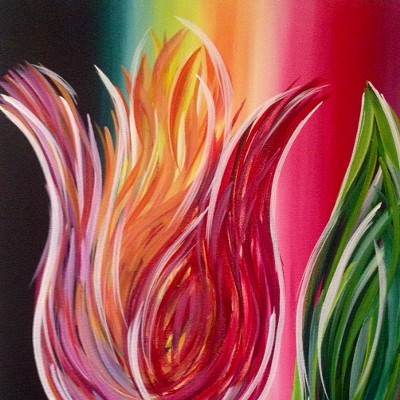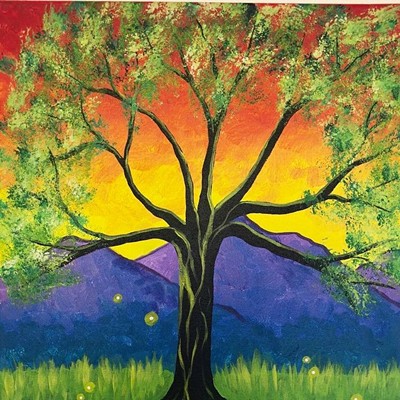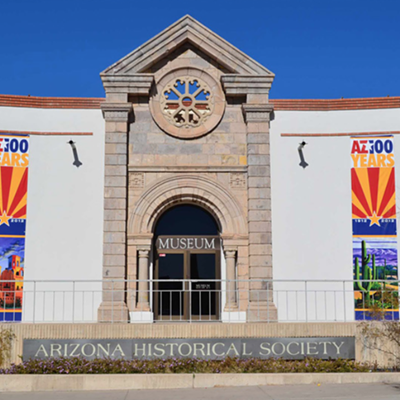Tucked behind adobe walls in Barrio Historico, Small's private gallery contained his collection of 700 works, mostly luxuriant paintings. The Annex, so-called, was as hidden as Anne Frank's, and the artists whose works it held were all sworn to secrecy.
It was only after Small's death in 1994 that Tucsonans learned of the newspaper tycoon's treasure trove, accumulated in part with the fortune he made by selling his family's papers, the Arizona Daily Star and the Tucson Citizen, to national chains. The year after his death, his art was carted by the truckload to the multiple museums--including the Tucson Museum of Art--that were his gleeful beneficiaries. (See "Hidden Treasures," Feb. 8, 1996.)
Since then, the gallery--a place of soaring skylights, white walls and concrete floors, designed by Small's architect son, William--has lain mostly fallow. But last year, a Tucson dentist by the name of Lisa Fogle decided to return it to its arts origins, and opened Gallery Centella in March.
"I fell in love with this space," Fogle said in the gallery one day last week. "What really fascinates me is that it's a contemporary gallery in an old historical space. This is the oldest area of Tucson, and you open the door and find contemporary art."
Fogle, who's run her eponymous dental practice on Swan for 25 years, intends to focus on contemporary and Latin-American art, drawing from a mixture of local, out-of-town and international artists. A big blonde with a personality perhaps as big as Small's, Fogle has a fondness for high fashion (spiked suede boots and a Jackie O. skirt this day) and a stature (around 6 feet) that matches her grand ambitions for the gallery.
"I have three big fascinations: the night sky, masks and words that start with the letter 'i.'" she declared. "Like 'impact.' I've always loved art. I was ready to take that passion for art and do something with it."
Centella (Spanish for "lightning flash") had a suitably flashy debut last spring with a solo show by Portland, Ore., glass artist Anna Skibska, a native of Poland who also exhibits in Europe. Her large sculptures, fashioned out of thin tubes of "lampworked" glass, erupted in a kind of glass forest over the gallery floor. Next up, in the fall, was Rodney Alan Greenblat, a 1980s East Village wunderkind who went on to some international success with cartoon-like paintings. Sony hired him to design some PlayStation games, Fogle said. An upcoming show will feature Jorge Marin, a Mexico City surrealist sculptor in bronze.
So how does a Tucson dentist accustomed to drilling teeth reel in such high-flying artists? Part of the answer is that Fogle and her husband, a retired psychiatrist, are out-and-about art collectors with plenty of connections. The other part seems to be moxie.
"I met Anna at the opening of the Mesa Art Center," Fogle said. "She was one of the opening artists." As for Greenblat, "We met, and I called and made an appointment and went to New York. Rodney has a big following, and people came in from all over for the show. And I just got back from Mexico City."
The current three-person show, Yatra: Return to the Self, is not quite so media-worthy, but it nevertheless features Beth Ames Swartz, a Phoenix abstract painter who's had a one-woman show at the Phoenix Art Museum, complete with hefty catalogue. Swartz is exhibiting 10 acrylic and mixed media paintings whose subtle colorations and floating shapes are "very spiritual," Fogle said. Inspired by T.S. Eliot's "Little Gidding," Swartz's series draws its name from the poem's final line, "And the fire and the rose are one."
Swartz's paintings are heavily worked and thickly layered--like the art Small favored--with the acrylics sometimes veering out three-dimensionally into space. "The Brief Sun Flames the Ice ... " glows in luscious reds, with pale stripes in chalky blue cascading down over dimly painted spheres. Sometimes, mysterious writing is scrawled across the surface, as in the blue-toned "If You Come This Way in May Time," which also has lively curves carved into the thick paint.
Amy Garcia, a Bay Area painter with 12 pieces on view, favors landscape-favored abstractions. Most of them are amorphous colorations of sky and land, but "City at Night" is a more interesting assemblage of blocky geometries. The third artist is Aryen Hart, a Dutch new-agey artist who lived in Tucson for a good chunk of the '90s. He has 13 spacey works that mix shiny polymer car paints with pigment on steel. "Sunyatta" has a floating Buddhist head at the center--one Buddhist head too many, in my view. More appealing are paintings mimicking the ripple of light on water.
Fogle is well aware of the high mortality rate of Tucson galleries.
"My husband reminds me every day," she joked. "But don't forget that I've started a business before, by myself, with no help from anybody. I'm just doing it."
To increase her shot at success, she's joined the Central Tucson Galleries Association and gotten the gallery into the group's brochure and map. She's hosted parties for the TMA's Contemporary Art Society and for the Chamber of Commerce, and she's staging a fundraiser/auction for University Medical Center's Steele Children's Research Center.
Fogle has also injected glamour into Tucson's casual art scene: At one opening, she wore a long, red gown with feather boa. And she's ratcheted up the fun factor via the performing arts. One opening included a mask dance and a mask-making workshop. For a show coming up this spring centered around UA artists and alums, Fogle promises performance artist Kate Long Hodges shimmying down from the skylights. And her extravagant food is already winning Centella a reputation for the best art parties in town. (Baklava and wine were offered the ordinary afternoon I visited.)
Fogle said the building, set in the historic Convent Avenue streetscape of Sonoran adobes, is a destination in itself. Visitors are welcome to stay awhile and lounge in the enclosed courtyard at tables under a palo verde. And she's already itching to go as big as Small. The Simpson Street office that he used is now occupied by a graphic artist; should he move, Fogle would like to snare that space, too.
"I'd like to put the whole Bill Small thing back together," she said. "I have 3,400 square feet, and sometimes, it feels too small."














